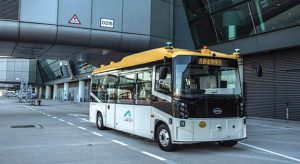Bloomberg
Hong Kong International Airport (HKIA) says it’s ready to use driverless buses, confident it can shuttle passengers around the aerodrome from next year after extensive trials years in the making.
By bolting on cameras, sensors and tracking devices, the Asian financial hub’s main airport has adapted and kitted out an electric bus from Chinese carmaker BYD Co and been testing so-called Level 4 autonomous technology.
The four-year effort, using other types of driverless
vehicles without passengers, has racked up around 130,000 kilometres (81,000 miles) without an accident, according to the airport.
“We can carry passengers to and from different destinations — totally driverless,†Chapman Fong, the airfield’s general manager, said.
Reaching full levels of autonomous driving with flawless safety in a real world environment is the holy grail for automakers and tech firms alike. But despite the tens of billions of dollars spent, it remains illusive. While self-driving trucks are being used in some controlled applications, like hauling rocks around a mine site, cars without humans that can navigate streets shared by pedestrians, pets and other vehicles don’t exist.
HKIA’s bus, a BYD J6 model, seats 14 passengers, features 10 cameras placed outside the vehicle from Uisee Technology (Beijing) Co. and uses GPS locators to track its position. A key part of the technology’s hardware is in a sizable, silver metal case next to where a driver would sit that contains the driverless unit and a back-up system that can independently scan the path ahead. If the main system fails, the back-up kicks in.
“For the autonomous technology we are quite confident because we have been using it for live operations and have had zero accidents,†Fong said.
It isn’t the airport’s first foray into high-tech transport.
HKIA deploys four battery-powered patrol cars made by SAIC-GM-Wuling Automobile as security to patrol the airfield perimeter and has a fleet of 12 battery-powered tractors towing passenger baggage containers.
 The Gulf Time Newspaper One of the finest business newspapers in the UAE brought to you by our professional writers and editors.
The Gulf Time Newspaper One of the finest business newspapers in the UAE brought to you by our professional writers and editors.
